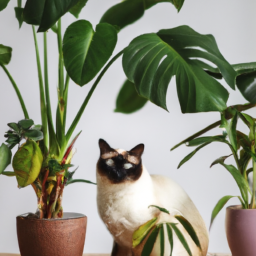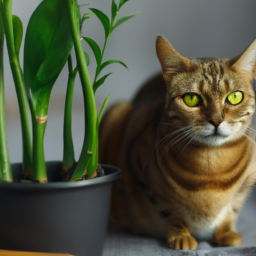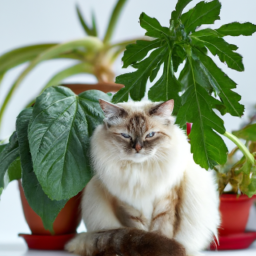
Are you a proud cat owner looking to add some greenery to your indoor space but worried about the safety of your feline friend? You’re not alone! Many cat owners face the dilemma of finding indoor plants that are safe for their curious pets. In this blog post, we’ll explore the question “What Indoor Plants Are Safe for Cats” and provide you with a comprehensive list of cat-friendly plants that will bring life to your home without posing a threat to your beloved furball. So, let’s dive in and discover some beautiful and safe options for your indoor garden!
Toxic vs. Non-Toxic Indoor Plants for Cats: A Comprehensive Guide
Understanding the Dangers of Toxic Plants
When it comes to choosing indoor plants for your home, it’s important to consider the safety of your feline friends. Many common houseplants can be toxic to cats if ingested, leading to symptoms ranging from mild gastrointestinal upset to more serious issues like organ failure. Some of the most common toxic plants for cats include lilies, philodendron, and aloe vera. These plants should be avoided at all costs if you have a curious cat in your home.
If you suspect that your cat has ingested a toxic plant, it’s important to seek veterinary care immediately. Symptoms of plant poisoning in cats can include vomiting, diarrhea, lethargy, and difficulty breathing. In severe cases, ingestion of toxic plants can be fatal. To keep your cat safe, it’s best to stick to non-toxic plants when choosing greenery for your indoor space.
Choosing Non-Toxic Plants for Your Home
Fortunately, there are plenty of beautiful and cat-safe indoor plants to choose from. Some popular options include spider plants, Boston ferns, and bamboo palms. These plants are not only safe for cats, but they can also help purify the air in your home and add a touch of greenery to your space. When selecting plants for your home, be sure to research each plant’s toxicity level to ensure that it is safe for your feline friend.
In addition to choosing non-toxic plants, it’s important to place them in areas that are out of reach of your cat. Cats are curious creatures and may be tempted to nibble on leaves or flowers, even if the plant is safe for them. Consider hanging plants from the ceiling or placing them on high shelves to prevent your cat from accessing them. You can also create a designated “cat-free zone” for your plants by using baby gates or other barriers to keep your furry friend away.
Tips for Maintaining a Cat-Safe Indoor Garden
In addition to choosing non-toxic plants and keeping them out of reach of your cat, there are a few other tips to help maintain a cat-safe indoor garden. Regularly inspect your plants for signs of damage or wilting, as some cats may be attracted to plants that are not healthy. Keep an eye out for any fallen leaves or flowers, as these can pose a choking hazard to your cat.
If you notice that your cat is showing interest in a particular plant, consider spraying it with a cat deterrent spray or placing citrus peels around the base of the plant. Cats are often repelled by the scent of citrus, which can help deter them from nibbling on your greenery. Finally, be sure to provide your cat with plenty of alternative sources of stimulation, such as toys and scratching posts, to keep them entertained and less likely to bother your plants.
By following these tips and choosing non-toxic plants for your indoor space, you can create a safe and beautiful environment for both you and your feline friend. With a little bit of research and planning, you can enjoy the benefits of indoor plants without putting your cat at risk.

Top 10 Indoor Plants That Are Safe for Cats: Keep Your Feline Friend Happy and Healthy
The Importance of Choosing Safe Indoor Plants for Cats
As a cat owner, it’s important to be mindful of the plants you bring into your home. Many common houseplants can be toxic to cats if ingested, causing symptoms ranging from mild gastrointestinal upset to more severe reactions. By choosing indoor plants that are safe for cats, you can create a pet-friendly environment that promotes the health and well-being of your feline friend.
When selecting indoor plants for your home, it’s essential to consider not only the aesthetic appeal but also the safety of your pets. By being aware of which plants are safe for cats, you can enjoy the beauty of greenery in your home without worrying about potential harm to your furry companion.
By following this guide to the top 10 indoor plants that are safe for cats, you can create a cat-friendly indoor garden that will keep your pet happy and healthy.
1. Spider Plant
The spider plant is a popular choice for cat owners because it is safe and non-toxic to cats. This plant is easy to care for and can thrive in a variety of indoor environments. The spider plant is known for its long, arching leaves and small white flowers, making it a visually appealing addition to any room.
In addition to being safe for cats, the spider plant has air-purifying properties that can help improve the air quality in your home. This plant is a great choice for cat owners who want to create a healthy and pet-friendly indoor environment.
To care for a spider plant, place it in indirect sunlight and water it regularly to keep the soil moist but not waterlogged. With proper care, your spider plant can thrive and provide a safe and attractive addition to your home.
2. Boston Fern
The Boston fern is another safe indoor plant for cats that can add a touch of greenery to your home. This plant is known for its lush, feathery fronds and can thrive in a humid environment, making it an excellent choice for bathrooms or kitchens.
Like the spider plant, the Boston fern has air-purifying properties that can help improve the air quality in your home. This plant is safe for cats and can provide a safe and attractive addition to your indoor space.
To care for a Boston fern, place it in indirect sunlight and keep the soil consistently moist. Mist the fronds regularly to maintain humidity levels and prevent them from drying out. With proper care, your Boston fern can thrive and provide a safe and beautiful addition to your home.
3. Areca Palm
The Areca palm is a safe indoor plant for cats that can add a tropical touch to your home. This plant is known for its graceful, arching fronds and can thrive in a bright, indirect light environment. The Areca palm is safe for cats and can provide a safe and attractive addition to your indoor space.
Like the spider plant and Boston fern, the Areca palm has air-purifying properties that can help improve the air quality in your home. This plant is a great choice for cat owners who want to create a healthy and pet-friendly indoor environment.
To care for an Areca palm, place it in bright, indirect sunlight and water it regularly to keep the soil consistently moist. With proper care, your Areca palm can thrive and provide a safe and beautiful addition to your home.

How to Create a Cat-Friendly Indoor Garden: Tips for Choosing Safe Plants
Understanding the Importance of Choosing Safe Plants for Your Indoor Garden
When it comes to creating a cat-friendly indoor garden, one of the most important factors to consider is the safety of the plants you choose. Cats are curious creatures and may nibble on plants out of boredom or curiosity. However, many common indoor plants can be toxic to cats if ingested. This is why it’s crucial to choose plants that are safe for your feline friends.
When selecting plants for your indoor garden, it’s essential to do your research and ensure that they are non-toxic to cats. Some plants that are safe for cats include spider plants, Boston ferns, and African violets. These plants not only add beauty to your indoor space but also provide a safe environment for your furry companions.
In addition to choosing safe plants, it’s also important to consider the placement of your indoor garden. Make sure to place plants out of reach of your cats, such as on high shelves or hanging planters. This will help prevent any accidental ingestion and keep your cats safe and healthy.
Tips for Choosing Safe Plants for Your Indoor Garden
When selecting plants for your cat-friendly indoor garden, there are a few key factors to consider. First and foremost, make sure to choose plants that are non-toxic to cats. Some common plants that are safe for cats include:
– Spider plants: These plants are easy to care for and safe for cats to be around.
– Boston ferns: These ferns are non-toxic and add a lush, green touch to your indoor space.
– African violets: These colorful plants are safe for cats and can brighten up any room.
It’s also important to consider the care requirements of the plants you choose. Make sure to select plants that are suitable for your indoor environment and that you can easily care for. This will help ensure that your plants thrive and provide a safe space for your cats to enjoy.
In addition to choosing safe plants, consider adding some cat-friendly herbs to your indoor garden. Cats love to nibble on fresh herbs like catnip, cat grass, and mint. Not only will these herbs provide a tasty treat for your feline friends, but they will also add a touch of greenery to your indoor space.
Maintaining a Cat-Friendly Indoor Garden
Once you have selected safe plants for your indoor garden, it’s important to maintain them properly to ensure the health and safety of your cats. Make sure to regularly water and fertilize your plants according to their specific care requirements. Keep an eye out for any signs of wilting or pest infestations and address them promptly.
It’s also a good idea to periodically inspect your plants for any signs of damage or decay. Remove any dead or dying leaves, as these can be a hazard to your cats if ingested. Additionally, keep an eye on your cats’ behavior around the plants and discourage any nibbling or chewing.
By following these tips for choosing safe plants and maintaining a cat-friendly indoor garden, you can create a beautiful and safe environment for both you and your feline friends to enjoy. Remember to do your research, choose plants that are non-toxic to cats, and provide proper care to ensure a happy and healthy indoor garden.
Summary Snapshot
If you’re a cat owner looking to add some greenery to your home, it’s important to choose indoor plants that are safe for your feline friend. Some common houseplants can be toxic to cats if ingested, so it’s essential to do your research before bringing any new plants into your space. Luckily, there are plenty of cat-friendly options that can help purify the air and add a touch of nature to your home.
Some safe indoor plants for cats include spider plants, Boston ferns, and African violets. These plants are non-toxic to cats and can thrive in indoor environments with proper care. Just be sure to keep any toxic plants out of reach of your curious kitty, and consider placing a few cat grass or catnip plants around your home to provide a safe alternative for your pet to nibble on. With a little planning and some careful selection, you can create a cat-friendly indoor garden that both you and your furry friend can enjoy.
FAQ Compilation:
Q1: Are there indoor plants that are safe for cats?
A1: Yes, there are several indoor plants that are safe for cats to be around. These plants are non-toxic to cats and can be a great addition to your home decor.
Q2: What are some examples of indoor plants that are safe for cats?
A2: Some examples of indoor plants that are safe for cats include spider plants, Boston ferns, African violets, and parlor palms. These plants are non-toxic to cats and won’t harm them if they decide to nibble on the leaves.
Q3: How can I ensure that the indoor plants I choose are safe for my cat?
A3: To ensure that the indoor plants you choose are safe for your cat, you can consult a list of non-toxic plants for cats from reputable sources such as the ASPCA. You can also ask your local nursery for recommendations on cat-safe plants.
Q4: What should I do if my cat ingests a toxic plant?
A4: If your cat ingests a toxic plant, it’s important to contact your veterinarian immediately. They can provide you with guidance on how to proceed and may recommend bringing your cat in for evaluation and treatment.
Q5: Can I still have indoor plants if my cat likes to chew on them?
A5: If your cat likes to chew on plants, you may want to consider placing the plants out of reach or opting for hanging plants that are harder for your cat to access. You can also provide your cat with alternative chewing options such as cat grass to deter them from nibbling on your indoor plants.
Dr. Olivia Green is a botanist with over two decades of experience in indoor plant cultivation. She holds a Ph.D. in Plant Biology and has dedicated her career to researching plant behavior in controlled environments. Dr. Green is passionate about helping plant enthusiasts master the art of indoor gardening through her extensive knowledge and practical insights.


